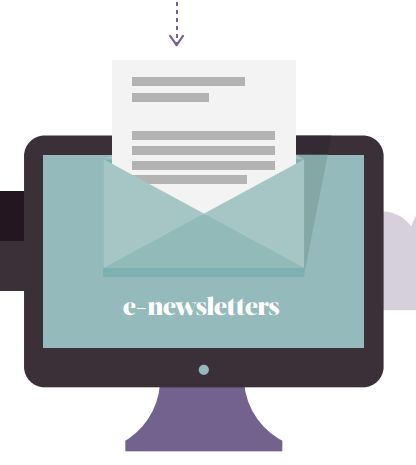
13 Apr Can e-newsletters build habits and new revenue?
There is simply too much information out there. Regardless of your field or area of interest, all of us are drowning in a fire hose of information aimed at us every minute of every day.
Most of us have no way to sort the wheat from the chaff, never mind actually understand the import of the stuff we really need to know. We all desperately need our own personal information concierge.
Enter e-newsletters
The greater the information flow, the higher the value of a concise, intelligent, personalised information curator, someone to bring order to chaos, someone we trust to tell us what’s worth paying attention to and what it means in the context of our area of interest. In 2013 and increasingly in 2014, magazine media have started coming to the rescue of their information-overloaded readers with e-newsletters delivering regular, laser-focused, tight, insightful compilations of the information readers really need to stay abreast of developments in their shared area of interest.
“Everyone is dealing with this huge fire hose of information and content,” Cliff Levy, editor of The New York Times “Daily Briefing” e-newsletter and NYT Now app told the Columbia Journalism Review.
“It’s really important for people to find someone they can rely on who can tell them that ‘these are the things you should pay attention to.”
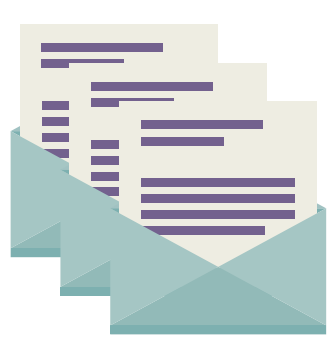
E-newsletters do exactly that
E-newsletters are a God-send for people who want to stay informed but dread going to multiple websites or being a slave to their Twitter streams to just keep up. Where Facebook gives you information based on an algorithm influenced by the need to show you ads for your favourite facial cream, e-newsletters by comparison have humans who share your interests (and whom you trust) hand-picking the news for you. A good newsletter delivers (almost) all of the information you need in a nice, tidy package delivered predictably to your email box to sit there and wait for you to consume it at a time that’s convenient for you.
Wait a second; didn’t we have e-newsletters in the nineties?
Well, yes, and then along came Facebook (2004) and Twitter (2006) and they became the au courant way to spread the word. Social media seemed to be more immediate and sharable and, well, cool. E-newsletters and email were not cool.
But Facebook and Twitter require constant monitoring, and then they only deliver partial packets of information… plus a tonne of distractions and noise.
So, after several years, the blush came off the social media rose, at least in terms of the efficient consumption of essential information. Too many kitty videos and baby-picture tweets became “time-suckers” for readers when all they wanted to do was get a briefing.
Welcome back, e-newsletters!
“Email is a 40-year-old technology that is not going away for very good reasons — it’s the cockroach of the internet.” digital media blogger Jason Hirschhorn told The New York Times.
“Email is dismissed as something old people use,” Quartz global news editor Gideon Litchfield told the NYT. “But in the past few years, we have started to see email as a peer to publishing platforms like Twitter, Facebook, and the web.”
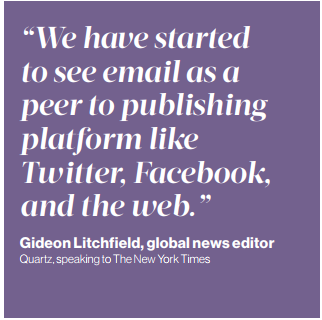 Put another way, no matter how involved in other things (online, social etc.) readers are, “the inbox is their homepage,” according to Quartz UK EMEA executive director Simon Davies. Email newsletters are more accessible than getting information via Twitter or Facebook because email allows readers to access it on their own terms.
Put another way, no matter how involved in other things (online, social etc.) readers are, “the inbox is their homepage,” according to Quartz UK EMEA executive director Simon Davies. Email newsletters are more accessible than getting information via Twitter or Facebook because email allows readers to access it on their own terms.
“Email sits in your inbox until you do something with it. You don’t have to look at it right away. It just kind of waits for you,” MailChimp editor Kiefer Lee told FastCompany.
“It’s quite an honour to have someone give you their email address.”
And now, with the increasing penetration of smartphones and the optimisation of e-newsletters for mobile devices, email newsletters are suddenly the most convenient, efficient, relevant device for staying up to date.
Looking at the most celebrated successes in the revitalised e-newsletter field — Quartz’s Daily Brief, The New York Times’ Daily Brief and Time Inc’s The Brief (couldn’t one of them not have used “Brief”?) — it is clear that high-quality, targeted e-newsletters are a big hit with readers, especially with time-starved, over-scheduled, high-powered executives.
Quartz itself and its daily e-newsletter ‘Daily Brief’ are aimed at C-level executives, a demanding demographic with no time to waste on ineffective services. The Daily Brief skyrocketed from an audience of zero in September 2012 to almost 100,000 and a sold-out ad inventory in just 25 months.
Beyond that, an average of half of the subscribers actually open the email, according to Davies. That’s more than double the industry average of 23 per cent reported by MailChimp.
Clearly, there was a need, and Daily Brief filled it.
In a follow-up study of 940 global executives, Quartz found that email is the preferred source for news, industry news, and sharing news. E-newsletters trumped the web and mobile apps as a source of news at 60 per cent, easily outdistancing dedicated news apps, social networks, or news sites on mobile or desktop.
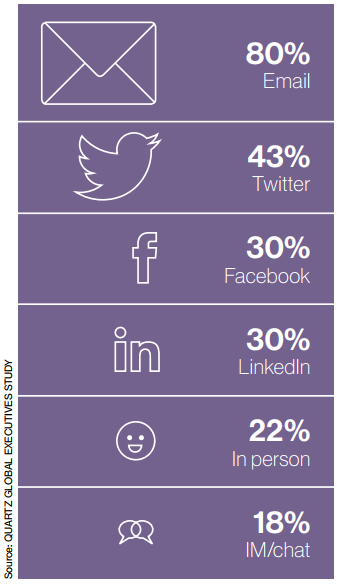
E-newsletters were also the top source for industry news, beating out industry and general news sites. And for sharing, email (83 per cent) topped Twitter (43), Facebook (30) and LinkedIn (30). Another survey (by email marketing company ExactTarget) found that 91 per cent of respondents checked email daily, but only 57 per cent checked their Facebook accounts daily. A stunningly meagre 14 per cent checked their Twitter accounts daily.
Another successful newsletter — Time.com’s The Brief — is a daily, early morning briefing newsletter with 650,000 subscribers and an open rate of 40 per cent. Another case of a need neatly met. And, if you don’t have time to read The Brief, Time Inc makes it available via podcast for the commute to work. Other media companies making successful forays into e-newsletter field include: Newsweek, Bloomberg, Fast Company, and Politico. Not every magazine has the resources of those heavy hitters, though. For those publishers, there are other options, ranging from the big e-newsletter distribution companies like MailChimp (7 million customers; 500 million daily emails delivered), Vertical Response (1 million customers), CheetahMail (190 million daily emails), and Constant Contact (625,000 customers); to smaller, simpler options such as Source: TinyLetter (owned by email firm MailChimp).
TinyLetter enables less well-funded organisations to create e-newsletters. TinyLetter has more than 10,000 users whose e-newsletters reach 9.3 million subscribers, a number that grew 15 per cent in the last year.
“I think my mom could use TinyLetter,” MailChimp’s Lee told Fast Company.
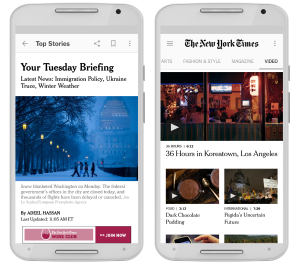
Image used courtesy of nytimes.com
New York Times’ Daily Briefing
Similarly, at The New York Times, the editors gave great thought to the personality of NYT Now and the Daily Briefing e-newsletter. They tried to determine, for example, how readers felt at 6am. What kind of content and what tone of voice would readers enjoy before or during their first cup of coffee? Definitely not the cold, matter-of-fact style of The New York Times, colloquially known as “The Grey Lady” for its historically high ratio of text copy to graphics. “We try to be a little… not orthodox-Timesian,” NYT Now/Daily Briefing editor Cliff Levy told the CJR. “We want to be your friend in the morning.”
So, what makes a successful e-newsletter?
While some newsletter practitioners will tell you creating a successful newsletter is an art not a science, there actually are some best practices that will increase your chances of getting and staying connected with your readers.
“A lot of the decisions about what to include and exclude are gut, based on decades of news judgment and experience,” Victoria Shannon, news editor of NYT Now told the Columbia Journalism Review (CJR).
That’s all well and good, and probably true, but it doesn’t help publishers conceive of, construct, organise, staff and execute a new e-newsletter.
There are three main criteria that are integral to the newsletter’s success, according to Quartz executive director for EMEA Simon Davies:
1. CONTENT
2. PERSONALITY
3. FORMAT
CONTENT:
The content must include any story from any source, not just your own content, if that story is relevant to your audience, Davies told FIPP Innovation Forum attendees in June 2014. The percentage of Quartz staff stories in the newsletter is all over the map, but never 100 per cent and often 15-20 per cent. “Audiences aren’t stupid,” Davies said. “They know there’s a big wide web out there.”
Not everyone agrees. Time Inc’s goal for readers of The Brief is not to provide the world’s best content, but “a snapshot in Time, as it were,” Time.com’s managing editor Edward Felsenthal told the journalism think tank, The Poynter Institute. All twelve stories in each edition come from Time.com.
That approach seems to be working: Prior to starting The Brief in March 2014, Time produced RSS-generated emails for ten different verticals and averaged 10 per cent open rates. “The Brief” gets 40 per cent open rates. And the click-through rates after opening the email are twice the industry average of just 16 per cent, Time Inc director of digital innovation Callie Schweitzer told Poynter.
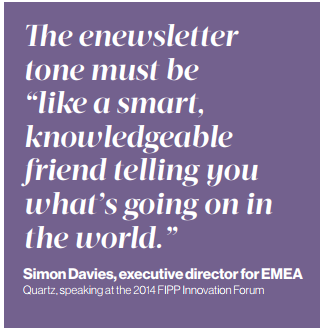
PERSONALITY:
Almost all of the new style e-newsletter editors agree that the voice must be that of a friend, albeit a smart and clever one. The tone must be “like a smart, knowledgeable friend telling you what’s going on in the world,” Davies told the Innovation Forum attendees.
That personality must be evident from start to finish. Davies said it begins with the subject line that not only gives a preview of the contents of the e-newsletter, but does so with varying degrees of seriousness. That continues throughout the body of the e-newsletter and is evident even at the end when Quartz closes with a friendly, clever sign-off.
FORMAT:
Whether an e-newsletter is called “The Briefing” or something similar, the idea is to deliver a limited amount of content concisely. It follows that the design must convey the same message: efficiency.
The presentation of Quartz is not gorgeous or laden down with photos but clean and simple, text-only, with no more than five sentences summarising each topic. The first sentence is in bold to make it easier to scan and read. Unlike some e-newsletters that do not include links (to guarantee the short time commitment), Quartz does link out to the full stories.
What does the consistently spare layout achieve? “For the smart, busy reader, this means the same time investment each day and the same value extracted,” Davies said. “It’s habit-forming.”
Make sign-up hassle-free
Executives at Quartz’s Daily Brief would add one more key to e-newsletter success: Make the sign-up process as hassle-free as possible. That wasn’t always the case at Daily Brief. With all the best intentions (future personalised services like personalisation, geolocation, read-it-later, offline mode, annotations, user settings), they required readers to create an account.
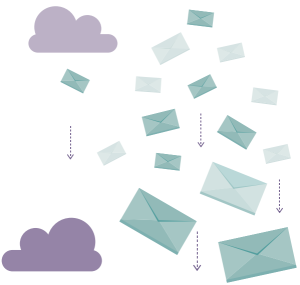
Big mistake.
“In reality, requiring accounts just slowed down the Daily Brief signup process for a lot of people, frustrated others, and turned many off from signing up entirely,” according to a Quartz spokesman.
Now, you only have to fill in two fields: Your email address and your time zone (so you get it at 6am your time). They also removed the requirement to go to an email to activate a subscription. Now the email is used only to opt out, making sign-up instantaneous.
“Since we rolled out the new system on February 19 [2014], our daily subscriber rate has doubled, even on weekends when activity dips considerably,” the Quartz spokesman said. “Users can now sign up via ‘in-stream units’ or through the Daily Brief landing page. Of the people that view that page, a full 60 per cent of them now go on to subscribe.”
Getting all of these things right has real benefits… and real consequences if you don’t.
“What’s exciting about email is: People invite you into this space and you get an opportunity to make a good first impression,” Dan Oshinsky, editor of BuzzFeed’s e-newsletters, told The Poynter Institute. “The downside is, if your emails are not good, you’re in a pretty important space, and people kick you out.”
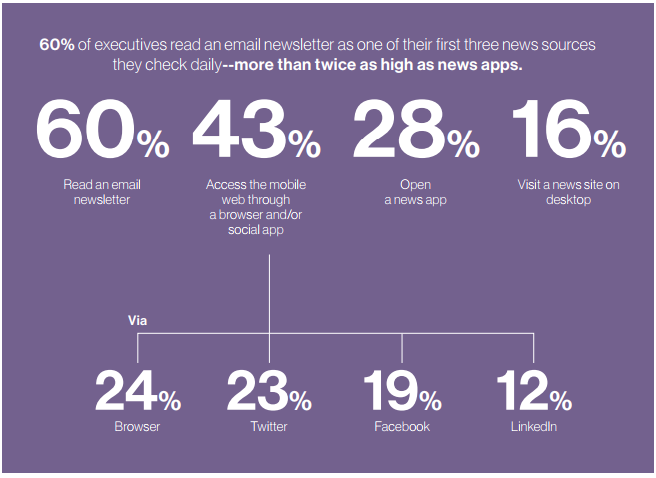
Measures of success
Much the way the advertising side of publishing used to count click-throughs to determine the success of banner ads (no more!), newsletter success used to be measured by the “silver bullet” of open rates.
Not anymore. Publishers who understand what’s important in their relationships with readers now know that it’s engagement that counts: How long do readers spend with the e-newsletter, how many links did they open, how many stories did they share, how often do they come back?
BuzzFeed, for example, not only de- emphasised open rates in favour of engagement measures, the company also monitors growth rates for every newsletter subscriber list (they have 14 e-newsletters). “They’re all important numbers that help us get a better view of whether or not a newsletter is really working,” Oshinsky told Poynter.
While BuzzFeed does not make its subscriber and open rates public, Oshinsky did reveal that newsletter-driven traffic to BuzzFeed was up 700 per cent year-on-year as of November 2014, according to Poynter. E-newsletters are in the top five or six biggest traffic drivers for BuzzFeed.
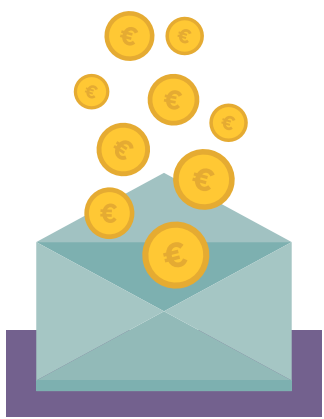 What makes a profitable e-newsletter?
What makes a profitable e-newsletter?
Quartz employs the same advertising strategy on its e-newsletter that it uses on its site: Sponsorship and native advertising. “It’s very lucrative,” said Davies. “In terms of ROI, it’s the most lucrative thing we have.” Advertisers can get a small native ad within the body of the newsletter, which is clearly labelled, and/or they get their company logo at the top with the words “Daily Brief sponsored by…”
What’s next? The personalised newsletter
OK, after all this exuberance over e-newsletters, is it possible we can do much, much better?
Absolutely. Think about it: Why are we delivering a one-size-fits-all newsletter to tens or hundreds of thousands of people in this age of laser-targeted, individualised advertising? (See our chapter on Programmatic Advertising.) You’ve had it happen to you all too (maddeningly) frequently. You search for a coffee maker one minute and see an ad pitching coffee makers served to your web browser seconds later.
If advertisers can do it, why not editors? (But tastefully)
One answer has been the general editorial notion that editors somehow know what’s best for us (and maybe, to some extent, they do). But the main reason has been that the technology to individually target e-newsletters was too expensive. No longer. Here are some innovative things magazines will be able to do very soon to personalise their e-newsletters and make them even more valuable to their readers and, thus, to their advertisers.
Over the last ten years, email marketing technology has advanced to the point of enabling publishers to deliver highly personalised and timely messages.
“With investment in enterprise data warehousing, algorithmic real-time data access technologies, and marketing automation platforms increasing, marketers are now empowered with the capability to harness big data to produce powerful, relevant, truly one-to-one communications,” according to Mark Ash, director UK and Ireland at big data company Teradata Interactive, writing in the digital marketing publication Fourth Source.
“If you combine those technologies, with more of a demanding customer set, you have to question whether the monthly newsletter is at risk of becoming redundant,” concluded Ash.
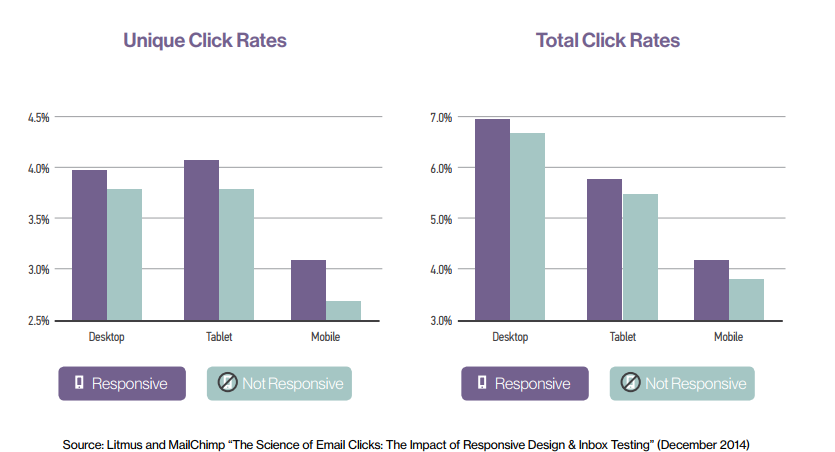
Here are five techniques in the email marketing space which could take magazine media e-newsletters to the next level, according to Ash:
- Huge growth in triggered messaging
Trigger messaging, also known as behavioural emails, are sent in response to a user action such as abandoning their purchase “cart” or signing up for a service. Triggered email open rates are four times higher than newsletters, according to Econsultancy. The Direct Marketing Association reported 125 per cent higher click-through rates.Triggered Messaging CEO Mike Austin found triggered messaging delivers a 12 per cent increase in revenue. Media companies could employ triggered messaging to personalise e-newsletters by gathering data on the stories readers click on and/or share, indicating a greater interest in that topic over the others in their e-newsletter. That is not to say that triggered messaging algorithms and big data would totally replace the editors’ choices for the day’s e-newsletters, but there could be a mix of personalisation and editorial selection. - XML or feed-based content
Some media companies have already given their readers the ability to tailor their emails or news alerts according to topics of interest. Magazines could create part of an e-newsletter by inserting stories created automatically via XML feeds.
- Nurture and lifecycle management
If retail brands can use customer nurture programmes and lifecycle management communication strategies to send a sequence of highly personalised messages to engage customers at various stages of the customer lifecycle, why not magazine media. While we’re not trying to sell anything (other than subscriptions), we are trying to create a lasting relationship. Brands have seen huge improvements in performance when they send far more relevant and timely emails to specific customer segments according to their position in the buying cycle, their purchase history and product affinities, according to Ash. The triggers for media companies could be things like reader inactivity for a period of time, welcome messaging, sudden intense interest in a particular topic, etc. - Integrated multi-channel engagement
Email campaigns are very rarely planned in isolation of other marketing activities, since marketers understand that synchronising marketing campaigns across multiple channels can help to reinforce the impact of their message and drive conversion, according to Ash. For media companies producing e-newsletters, multi-channel engagement could take the form of tailored advertisements in the e-newsletter and in other forms of interaction with the company. - Predictive-offer selection
More and more companies are turning to technology to help them decide on the best offer to show to their users, according to Ash.“In other digital channels such as display, we have seen the adoption of algorithm-based machine decision-making, which selects the most appropriate offer to show to a particular user in real-time,” Ash wrote.“The same functionality is being applied more and more across the email channel with templates being dynamically created and predictively modelled on a user’s previous history.”
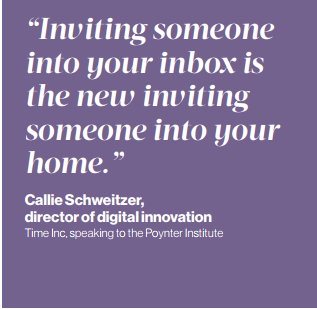
So, How does this transform e-newsletters?
“E-newsletters still have a role to play summarising the highlights of the week, but their role in the marketing mix is changing,” wrote Ash.
E-newsletters editors have the potential to deliver rich, personalised, targeted content, which is increasingly becoming a vital tool in influencing consumer behaviour, according to Ash. But media companies must invest in the right tools to give themselves the ability to do so.
E-newsletters can play a significant role in creating a substantial new revenue stream for magazine media companies. But it’s not something we can put on automatic pilot. We must continue to earn our place in our readers’ email boxes. Every day.
“I always say that inviting someone into your inbox is the new inviting someone into your home,” Time Inc’s Schweitzer said. “You have to earn the right to be there, but you also have to earn the right to stay there.


